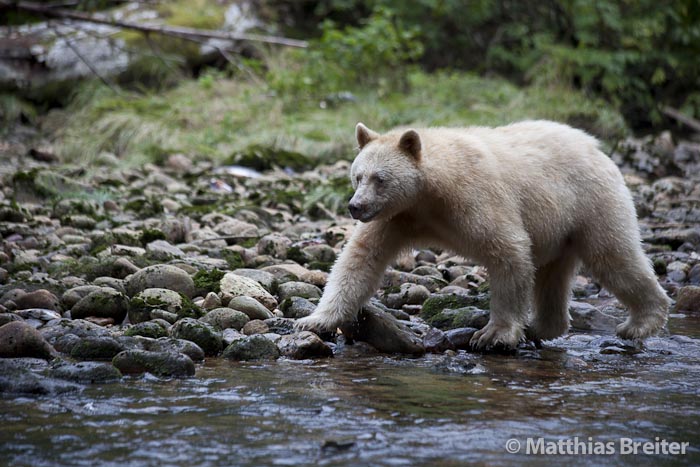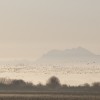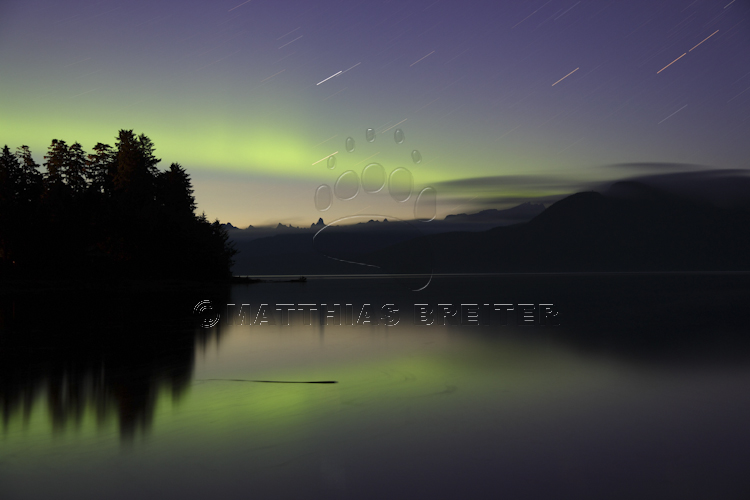
The Spirit Bear or Kermode Bear – Why Are They White?
Some facts about the “Spirit Bear”:
- Also called the Kermode Bear
- It is found almost exclusively on Princess Royal Island off the coast of Alaska
- It is not an albino – it is a subspecies of the American Black Bear
- Approximately one in every ten of this particular subspecies is born white
- White mothers can have black cubs and black mothers can have white cubs
- They are better at fishing than their black cousins
The spirit bear owes its existence to a recessive allele, a mutation in a pigmentation gene. It is the same gene that produces the yellow-blonde coat in golden retrievers. Because of small founder populations increasing the chance of inbreeding, and limited exchange of genetic material with the outside world, this gene has become widespread on the islands. Two-thirds of the bears on Princess Royal Island are carriers of the gene. However, a cream-colored cub is born only if both copies of the gene on its chromosomes consist of the recessive allele. Thus, following Mendel’s Law of heredity, if both parents are carriers, the mating of a black female and a black male may result in a mixed litter of both white and dark cubs. And a Kermode female will have exclusively black cubs if her partner is not a carrier.
The indigenous people of the region know these bears as Moksgm’ol and hold them in high esteem. The animals have a prominent place in the mythology of local First Nations.
From Matthias Breiter’s book Inside Passage. Click on the link below to view a short video about the legend of this mysterious bear.
The Legend of the Spirit Bear and the Land and People it came from from Twyla Roscovich on Vimeo.
Sea Otter Population in Glacier Bay
Sea otters have made a huge comeback in recent decades. They were almost wiped out completely by the end of the nineteenth century due to the fur trade. Today, rafts containing several hundred sea otters can be seen around kelp beds behind Drake and Willoughby Island in Glacier Bay. However, populations fluctuate greatly. They are still reclaiming their former range.
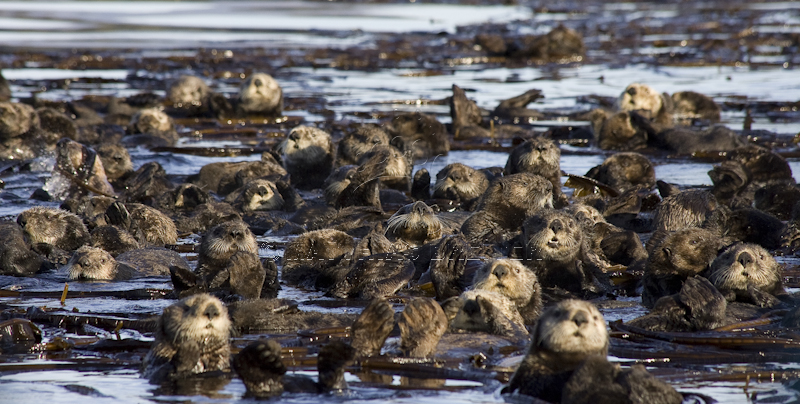
In their absence, their food sources, including sea urchins, exploded with dire consequence to kelp forests. This had an impact on the reproduction of small feed fish, which are important to salmon and whales. Due to an unnaturally high abundance of prey, sea otters tend to overharvest an area and move on when little is left, leaving a depleted seabed behind. This pattern of extremes will continue for quite some time until a balance is reached again. The longterm health and productivity of these marine ecosystems benefits greatly from the presence of these playful and endearing creatures.
To read more check out Matthias Breiter’s award-winning book Inside Passage with stunning Alaskan wildlife photography.
Salmon Season for Brown Bears and Black Bears
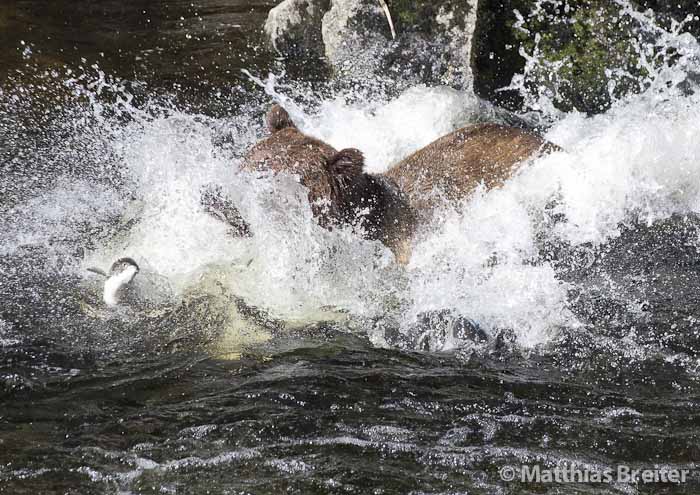 …If push comes to shove, the brown bears are dominant but mostly a fragile truce prevails. [Referring to brown bears and black bears fishing for salmon in the waters of Anan Creek south of Wrangell, Alaska] In times of overabundance, strife over a copious resource is a waste of effort. Still, black bear females, in particular females with young, usually abandon their fishing spot and leave the river or seek shelter up high in a tree when the bruins appear on the scene. Some juvenile brown bears apparently regard it as good sport to chase their smaller cousins. Mature male black bears generally stand their ground against these hooligans.
…If push comes to shove, the brown bears are dominant but mostly a fragile truce prevails. [Referring to brown bears and black bears fishing for salmon in the waters of Anan Creek south of Wrangell, Alaska] In times of overabundance, strife over a copious resource is a waste of effort. Still, black bear females, in particular females with young, usually abandon their fishing spot and leave the river or seek shelter up high in a tree when the bruins appear on the scene. Some juvenile brown bears apparently regard it as good sport to chase their smaller cousins. Mature male black bears generally stand their ground against these hooligans.
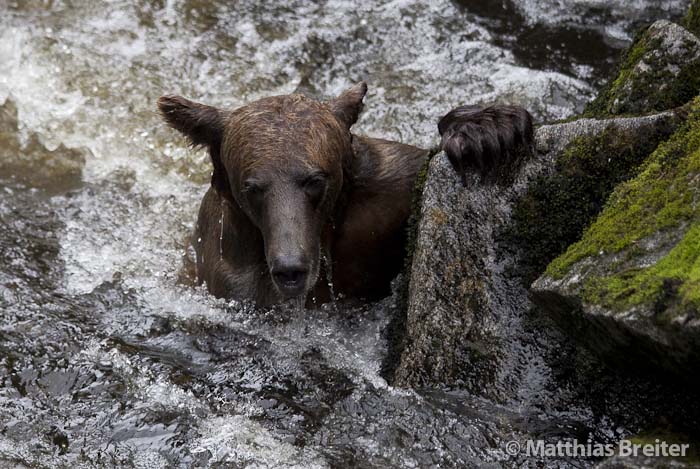
At the peak of the salmon season, between mid-July and mid-August, as many as fifteen bears can be seen fishing along the stream at the same time. Individuals who are skinny at the start of the fish run are often plump by the end of it, adding as much as two pounds of fat to their stocky frame per day. Salmon lie piled up in dense rows in the pools below small waterfalls, waiting for their turn to leap the obstacles in the river. Bears line the river, staring at the water and the promised meal contained within. Fishing techniques vary between individual bears and also between the two bear species. Some hurl themselves into the midst of schools of fish, others dive below waterfalls, again others simply stand midstream hoping for a disoriented fish to get within their reach. Generally the brown bears take a more active role in the pursuit of their prey, leaping into the stream and chasing fish into shallows. Most black bears, possibly as they feel more vulnerable, wait on the water’s edge for the opportunity to quickly grab a fish and retreat back into little caves among the boulders piled up next to the river. 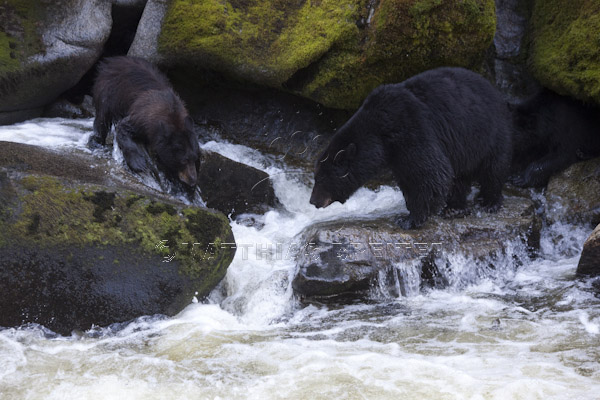 Cubs learn from their mothers. Fishing techniques get passed on to the next generation and favorite fishing spots get reused by daughters and sons. Brown bear cubs sit right on the bank of the river while their mother fishes. By comparison, the offspring of a black bear female are more cautious and watch her fishing from high in a tree or sit at the base of one, always ready to scramble up the trunk to safety. The river is a dangerous place for young bears. A lack of caution, a moment of inattentiveness, can have fatal consequences. For cubs, the salmon run is a stressful, scary time of the year, a time when they have to weigh boldness against caution. Sows only feed cubs that demand a meal. A cub that is too shy, won’t get much food; one that is too courageous may not live to see the fall.
Cubs learn from their mothers. Fishing techniques get passed on to the next generation and favorite fishing spots get reused by daughters and sons. Brown bear cubs sit right on the bank of the river while their mother fishes. By comparison, the offspring of a black bear female are more cautious and watch her fishing from high in a tree or sit at the base of one, always ready to scramble up the trunk to safety. The river is a dangerous place for young bears. A lack of caution, a moment of inattentiveness, can have fatal consequences. For cubs, the salmon run is a stressful, scary time of the year, a time when they have to weigh boldness against caution. Sows only feed cubs that demand a meal. A cub that is too shy, won’t get much food; one that is too courageous may not live to see the fall.
From Matthias’s book on bears and Alaskan wildlife – Wild Alaska. View images from the book.
